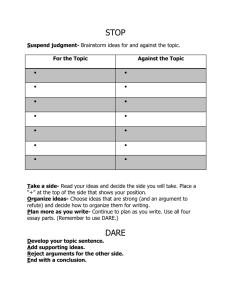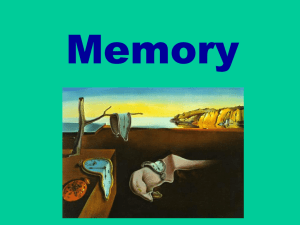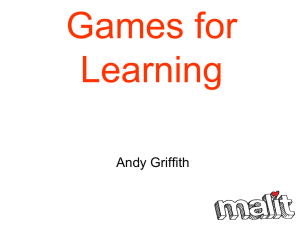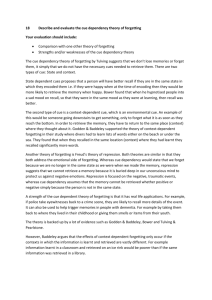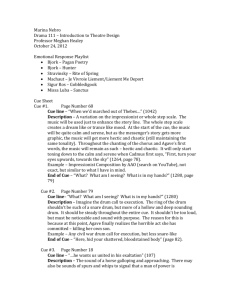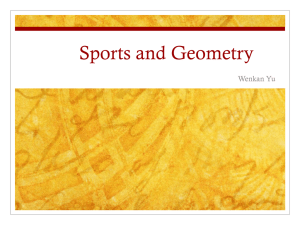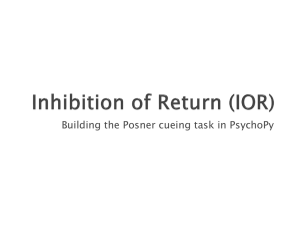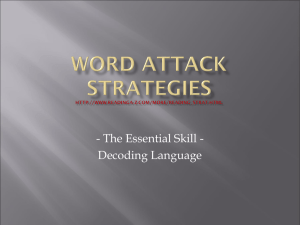Understanding_By_DesignCh3
advertisement
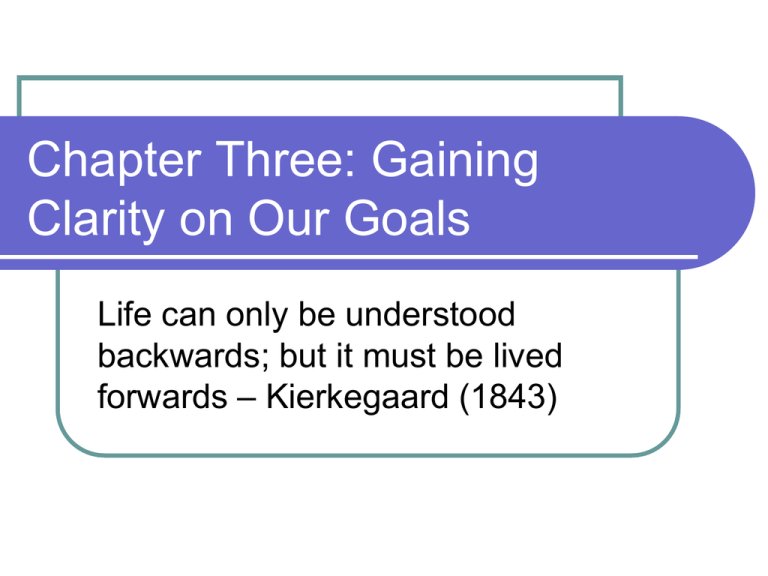
Chapter Three: Gaining Clarity on Our Goals Life can only be understood backwards; but it must be lived forwards – Kierkegaard (1843) UBD is Goal Directed We aim for specific results and design backward from them accordingly. The desired results in Stage 1 dictate the nature of the assessment evidence needed in Stage 2 and suggest the types of instruction and learning experiences planned in Stage 3 Avoid the “twin sins:” aimless coverage of content, and isolated activities that are merely engaging (at best) while disconnected from intellectual goals in the learners mind. A teacher hasn’t taught until the student has learned, no matter how elegant you think your lesson is. - RJH p.56 See Figure 3.1: Stage 1 Established Goals Desired Understandings Content standards, course/program objectives, learning outcomes Enduring Understandings based upon Transferable big ideas that set the context for content meaning, facts and skills Essential Questions Frame EQ’s to guide student inquiry and focus instruction on the important ideas in the content p.57 See Figure 3.1: Stage 1 continued Key Knowledge/skills students will acquire Targeted knowledge can be three kinds Building Blocks for desired understandings Knowledge and skills stated or implied in the goals Reference “enabling” knowledge and skills needed to perform the complex assessment tasks identified in Stage 2 p.57 Unpacking Standards Common complaint is that there are too many, too big, too small, or too vague Solution: Unpack the big ideas (GI’s) and core tasks I don’t have the time (wah, wah, wah) Unpacking World Geography Standard “The student will analyze the regional development of Asia, Africa, the Middle East, Latin America, and the Caribbean, in terms of physical, economic, and cultural characteristics and historical evolution from 1000 A.D to the present” Unpacking World Geography Standard Re-framed “The geography, climate, and natural resources of a region influence the lifestyle, culture, and economy of its inhabitants”. Essential Question: “How does where you live influence how you live and work?” Transferability: Compare the early civilizations of the Indus River Valley and the Huang-He of China .” See figure 3.2, p.64 Unpacking Standards - Research How People Learn (Bransford, Brown, & Cocking, 2000) A key finding in the learning and transfer literature is that organizing information into a conceptual framework allows for greater transfer. (p.17) Learning with understanding is more likely to promote transfer than simply memorizing information from a text or a lecture (p.236) Unpacking Standards - Research Experts first seek to develop an understanding of problems, and this often involves thinking in terms of core concepts or big ideas. Novices’ knowledge is much less likely to be organized around big ideas; novices are more likely to approach problems by searching for correct formulas and pat answers that fit their everyday intuitions. (p.49) Big Ideas? Core Tasks? UBD guarantees nothing. It’s elegant application ensures its power and effect. Every topic has more “content” than anyone can reasonably address therefore we must make deliberate choices and set explicit priorities. See Figure 3.3 p. 66 Big Ideas? Core Tasks? Learners should be able to answer these questions: What is most important here? How do the pieces connect? What should I pay most attention to? What are the (few) bottom line priorities? Big Ideas connect the dots – conceptual Velcro! The challenge: Identify a few big ideas and design carefully around them and teach “surgically” around them. p. 66 Five Biggest Ideas in Science Quantum physic’s model of the atom Chemistry’s Periodic Law Astronomy’s Big Bang Theory Geology’s Plate Tectonics Model Biology’s Theory of Evolution What questions do they answer? (Wynn & Wiggins, 1997) Big Ideas at the “core” of a subject Need to be uncovered through Inquiry (Gotta go slow to go fast) Big Ideas are the hard-won results of inquiry, ways of thinking and perceiving that are the province of the expert BI’s are not obvious Most expert BI’s are abstract and counterintuitive to the novice, prone to misunderstanding Big Ideas at the “Core” vs. “Basics Basic Terms • Ecosystem • Graph • Four basic operations • • • Picture composition Fact v. Opinion Experiment Core Ideas • Natural selection • “Best fit” data curve • Associativity and transitivity • Negative space • Credible thesis • Inherent error and fallibility of methods and results The big ideas at the core of a subject are arrived at, sometimes slowly, by teacher-led inquiries and reflective work by students Uncovered by design, understandings and essential questions that push to the core of a subject. “Excavate the essence” of a subject or topic” – (RJH, 2002) SpEd students work to uncover the essence (BI’s) of Macbeth – honor and loyalty Essential Questions: What are the difference between things that happen to us and things that we make happen? What is honor? Is there a cost or price for honor? Is it worth it? What is loyalty? Is there tension between loyalty and honor in Macbeth? In our own lives? Why is defending your honor so hard? Core Idea of Loyalty… Involves inescapable dilemmas, because loyalties invariably collide. Learning that does not penetrate to the core of what is vital about an idea yields abstract, alien, and uninteresting lessons. p.68 Attributes of “Big Ideas” Broad and Abstract Represented by one or two words Universal in application Timeless Represented by different examples that share common attributes Lynn Erikson, 2001, p.35 W & McT define BI’s as… Providing a focusing conceptual lens for any study Providing breadth of meaning by connecting and organizing many facts, skills, and experiences; serving as the linchpin of understanding Pointing to ideas at the heart of expert understanding of the subject W & McT define BI’s as… Requiring “uncoverage” because its meaning or value is rarely obvious to the learner, is counterintuitive or prone to misunderstanding Having great transfer value: applying to many other inquiries and issues over time – “horizontally” (across subjects) and “vertically” (through the years and in later courses) in the curriculum and out of school. W & McT define BI’s, and finally… A BI is not merely “big” by virtue of its intellectual scope. IT has to have pedagogical power; and, most notably, be helpful in making new, unfamiliar ideas seem more familiar A BI is not another fact or vague abstraction but a conceptual tool for sharpening thinking, connecting discrepant pieces of knowledge, and equipping learners for transferable applications What “big idea” has helped you thus far in making new, unfamiliar ideas seem more familiar? BI’s typically manifest Concept Theme Ongoing debate and point of view Paradox Theory Underlying assumption Recurring question Understanding or Principle p.70 A Prioritizing Framework What content is worth being familiar with? What content is important to know and do? What are the Big Ideas and Core Tasks? See Figure 3.3. Upon reflection, what priorities have you noticed thus far in UBD and how might you use them to reframe your instruction? See “More tips for finding big ideas” pp.73-78 Framing Goals for Transfer Core tasks are the most important performance demands in any field Core tasks are authentic and involve realistic situations Core tasks are contextually aligned to real-world opportunities and difficulties Core tasks reflect the transfer with big ideas sought over time. They are not merely interesting assessments. Framing Goals for Transfer Core tasks with authentic challenges embody our educational aims: The goal of school is fluent and effective performance in the world, not mere verbal or physical response to narrow prompts Transfer, reflective of understanding, involves expertly addressing authentic challenges at core tasks, where content is a means. Successful transfer means that students can perform well with minimal hand-holding, guidance, or cueing by teachers Framing Goals for Transfer A challenge of reading a text is to gain an understanding of what the text might mean, despite the obstacles of ones ABBA’s, limited tools and experience as a reader A challenge in music is to turn a complex set of instructions onto a fluent and moving whole, more than just the sum of the notes Framing Goals for Transfer A challenge in studying another language is to successfully translate meaning idiomatically, not just do a 1 to 1 translation of each word Your turn Transfer Demand/Degree of Cue 4. The task looks unfamiliar, even odd or puzzling, and is presented without cues as to how to approach or solve it. Success depends on “far transfer.” 3. The task looks unfamiliar but is presented with clues or cues meant to suggest the approach or content called for (or to narrow the options considerably). Success depends on realizing what recent learning applies in this somewhat ambiguous or different scenario – “near transfer.” Transfer Demand/Degree of Cue 2. The task is presented with explicit reference to ideas, topics, or tasks previously studied, but no reference is made to the specific rule or formula that applies. Minimal transfer is requires. Success requires recognition and application of which rule applies and uses it. 1. The task is presented so that the student need only follow directions and use recall and logic to complete it. No transfer is required – simply a “plug-and play” approach. Transfer Demand/Degree of Cue Challenging tasks at the core of a subject can clearly help us prioritize our aims if we think of them as organizing clusters of related knowledge and skill They would be the performance equivalent of Phenix’s “representative ideas” in each field Transfer Demand/Degree of Cue Core tasks embody: Key state and local standards and goals Are related to Stage 1 Specify the conditions that any proposed assessment must meet in Stage 2 Clarity that makes it far more likely that our goals will be intellectually vital and coherent Academic goals setting process should mirror authentic performance-based goals in the arts, athletics, or carpentry. Hey, where the hell is Bob? See what Bob is up to? What about his journey resonates with you? What questions are raised? What “aha” moments have occurred? p.81 Transfer Demand/Degree of Cue What transfer/cue demand is required of your NCATE assignment? What transfer/cue demand is required of your classroom assignments? No wonder we and our students are struggling in the “real world!”


